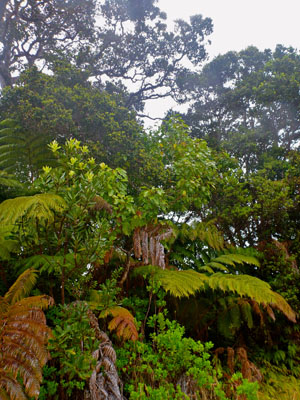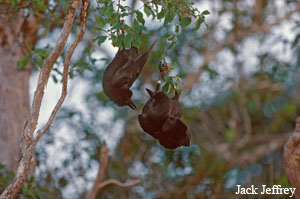Release
As the ʻalalā return to their native habitat, it is critical that lands managers, scientists, and community members work together as “ʻAlalā Ambassadors,” ensuring that the birds have the space, environment, and support they need to thrive.
Release Locations
- From 1993-1998 juvenile ʻAlalā were released within the remnant habitat of the last wild ʻAlalā. These efforts were considered unsuccessful due to the habitat lacking complex forest understory.
- The release efforts from 2016-2019 occurred in the Puʻu Makaʻala Natural Area Reserve on Hawaiʻi Island. Puʻu Makaʻala Natural Area Reserve has been managed for many years to promote native forests, is fenced and free of ungulates (cows, pigs, sheep, etc.), has a dense understory, and lots of ʻAlalā food plants. The release efforts from 2016-2019 showed marked improvement from conditions in the 1990s with multiple breeding pairs and nests formed. Increasing mortalities, including depredation by ʻIo, led to the recapture of remaining birds.
- The Kaʻū Forest Reserve is a potential area for future releases on Hawaiʻi Island. It is hoped that releases could be planned for the Kaʻū Forest Reserve with additional management promoting native forest habitat.
- A cohort of 5 juvenile ʻalalā are currently flying free on the slopes of Haleakalā. The cohort is monitored daily and supplemental food is being provided.

Project Goals
- Establish a wild self-sustaining population of ʻAlalā.
- The wild ʻAlalā will fulfill their ecological roles in the native forest ecosystem.
- Have a self-sustaining population in the wild requiring minimal support from humans.
A successful reintroduction will require:
- Habitat management to restore and protect native forests
- Non-native predator control
- Management of captive ʻalalā
- Release of birds
- Post-release monitoring
- Public support, outreach, and education

No kākou ke kuleana. The responsibility lies with each and every one of us to make sure that the ʻalalā will be welcomed home to our Hawaiian forests once again. We must build community-wide support from our keiki to kūpuna.
See News & Events for latest release updates
